Hypars, Leibniz, Newton, Félix Candela & Arthur Erickson
Friday, October 12, 2007
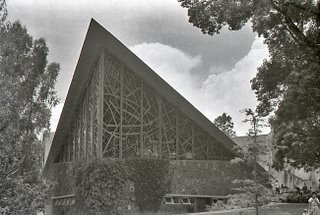 Felix Candela
Felix Candela(b. Madrid, Spain 1910; d. 1997)
Felix Candela was born in Madrid in 1910. He entered Madrid's Escuela Superior de Arquitectura in 1927 and graduated in 1935. Sidetracked by his political struggle against Franco, he did not practice architecture until he emigrated to Mexico in 1939.
Candela believed that strength should come from form not mass. This belief led to an extensive exploration of tensile shell structures. His nickname became "The Shell Builder" because of this structural favoritism.
Frequently forced to act as architect, structural engineer and contractor in order to further his work, Candela sees architects as engineers who possess the ability to design both great cathedrals and low cost housing.
References
Dennis Sharp. The Illustrated Encyclopedia of Architects and Architecture. New York: Quatro Publishing, 1991. ISBN 0-8230-2539-X. NA40.I45. p35.
Gottfried Wilhelm Leibniz and Sir Isaac Newton co-discovered the calculus in the 17th century and unleashed on the world the destructive power of ballistics. Before the limits, derivatives, integrals, and infinite series of the calculus, ballistics was all guess work. With Newton's discovery of gravity this meant that military engineers could predict with a fair amount of accuracy where a canon shell would fall. And of course the calculus in combination with the German V-2 rocket presaged the cold war and the accurate delivery of a mutually assured atomic destruction.
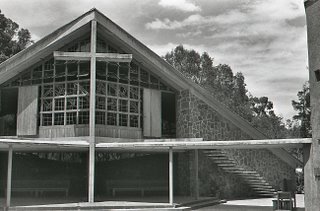
But the calculus enabled mathematicians to discover the formulas for calculating the volume of cylinders, cones, spheres and of irregular three dimensional shapes. Along the way curves like parabolas and hyperbolas could be studied under the concept of infinitesimals. Somebody, perhaps in the late 19th century, may have found a practical application of studying these curves in three dimensions and noting the shape that was subsequently made in that space. That person may have held four or five pencils in one hand (with the points touching on one end while fanning out the pencils, not only in relation to their length and width but also in depth) and been amazed at the shape. This shape is called a hyperbolic paraboloid or hypar. That shape can be constructed by using perfectly straight metal or wooden beams.
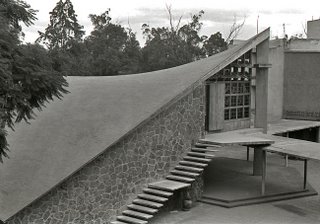
In Mexico architect/structural engineer/contractor Felix Candela popularized the thin concrete shell. To this day even some of the old Pemex gas stations built in the 50s and 60s (and perhaps inspired by Candela) still stand with their wonderful swooping concrete shells.
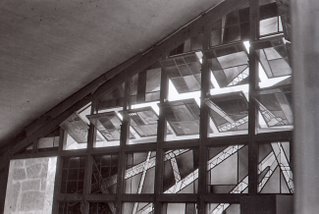
Around 1962 I first found out about the Capilla (chapel) de Nuestra Señora de la Soledad in the Mexico City suburb of Churubusco. This chapel, affectionately called El Altillo (small hill) was built by architect Enrique de la Mora y Palomar in collaboration with Fernadez López Carmona and Félix Candela (the structural engineer). The beautiful stained glass windows were designed by Kitzia Hoffman. My initial interest had nothing to do with this chapel that was built in the middle of a 17th century monastery. Those that knew went to Sunday Mass at 10am to hear the monks sing in a spectacular Gregorian chant. But when I noted the architecture and saw the deceptively complex (or simple depending from which side you saw it) I knew I wanted to return with my Pentacon-F 35mm camera and its one 50mm lens.
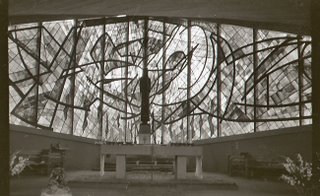
It was around 1964 that I learned integral and differential calculus and was able to see how the volume of a cone was calculated (there are two wonderful ways). It was a small "Road to Damascus" sort of thing for me as was the discovery of the concept of a straight line with an infinitely varying slope in three dimensional space. I then came to understand Candela's obsession with hypars.
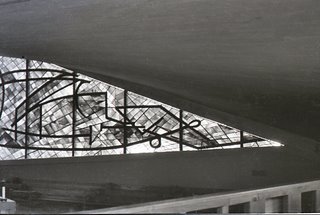
Now there is this new building designed by Arthur Erickson that is being built on Georgia Street. The building has a twist and.........
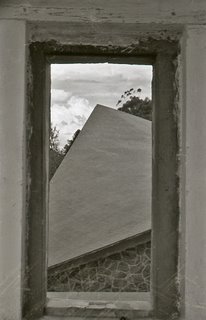
For beautiful colour photographs of "El Altillo" by Mexican architect José Luís Parella look here






